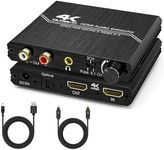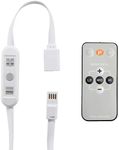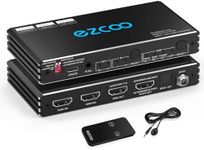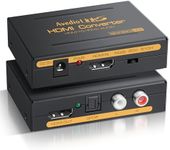Buying Guide for the Best Hdmi Audio Extractor
When choosing an HDMI audio extractor, it's important to understand how it works and what features you need to look for to ensure it meets your requirements. An HDMI audio extractor allows you to separate the audio signal from an HDMI source, such as a Blu-ray player or gaming console, and send it to an external audio system while still sending the video signal to your TV or monitor. This can be particularly useful if you have a high-quality audio system that you want to use with your HDMI devices. Here are some key specifications to consider when selecting an HDMI audio extractor.Audio Output OptionsAudio output options refer to the types of audio connections available on the extractor, such as optical (TOSLINK), coaxial, or 3.5mm stereo. This spec is important because it determines how you can connect the extractor to your audio system. If you have a high-end audio system, you might prefer optical or coaxial outputs for better sound quality. For simpler setups, a 3.5mm stereo output might suffice. Choose an extractor with the output options that match your audio equipment.
Supported Audio FormatsSupported audio formats indicate the types of audio signals the extractor can handle, such as Dolby Digital, DTS, or PCM. This is crucial because it affects the quality and compatibility of the audio output. If you have a surround sound system, you'll want an extractor that supports multi-channel audio formats like Dolby Digital or DTS. For basic stereo systems, PCM support might be enough. Consider the audio capabilities of your system and choose an extractor that supports the necessary formats.
HDMI Version CompatibilityHDMI version compatibility refers to the HDMI standards the extractor supports, such as HDMI 1.4, 2.0, or 2.1. This is important because it affects the video and audio quality, as well as the features available. For example, HDMI 2.0 supports 4K video at 60Hz, while HDMI 2.1 supports higher resolutions and refresh rates. Ensure the extractor is compatible with the HDMI version of your source device and display to get the best performance.
Pass-Through CapabilitiesPass-through capabilities refer to the extractor's ability to pass the video signal through to the display without degrading quality. This is important to ensure that you get the best possible video quality on your TV or monitor. Look for extractors that support 4K pass-through if you have a 4K TV, or HDR pass-through if you want to maintain high dynamic range content. Choose an extractor that matches the video quality requirements of your display.
Ease of UseEase of use encompasses the setup process, user interface, and any additional features that make the extractor simple to operate. This is important because a complicated device can be frustrating to use. Look for extractors with clear instructions, intuitive controls, and features like automatic switching or remote control. Consider your comfort level with technology and choose an extractor that you find easy to set up and use.
Build Quality and ReliabilityBuild quality and reliability refer to the materials and construction of the extractor, as well as its overall durability. This is important because a well-built extractor is likely to last longer and perform more consistently. Look for extractors made from high-quality materials with good reviews for reliability. Consider how often you will use the extractor and in what environment, and choose one that is built to withstand your usage.

















